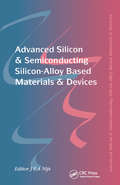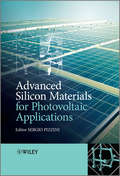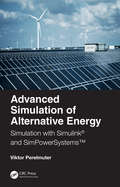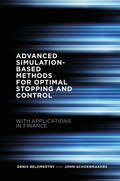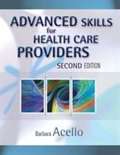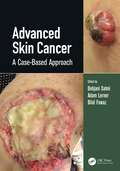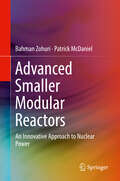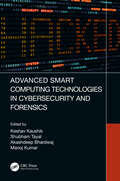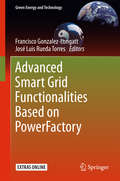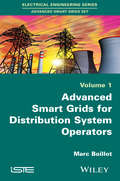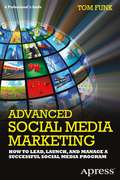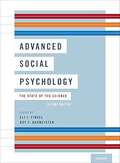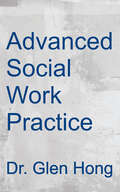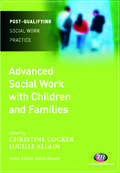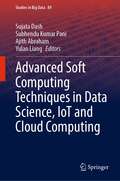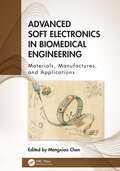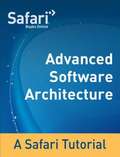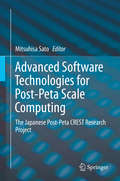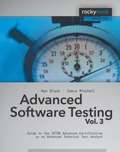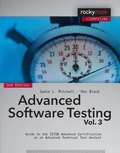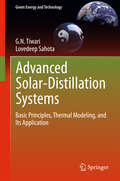- Table View
- List View
Advanced Silicon & Semiconducting Silicon-Alloy Based Materials & Devices
by Johan F A NijsOne of the first books to cover advanced silicon-based technologies, Advanced Silicon and Semiconducting Silicon Alloy-Based Materials and Devices presents important directions for research into silicon, its alloy-based semiconducting devices, and its development in commercial applications. The first section deals with single/mono crystalline silicon, focusing on the effects of heavy doping; the structure and electronic properties of defects and their impact on devices; the MBE of silicon, silicon alloys, and metals; CVD techniques for silicon and silicon germanium; the material properties of silicon germanium strained layers; silicon germanium heterojunction bipolar applications; FETs, IR detectors, and resonant tunneling devices in silicon, silicon germanium, and d-doped silicon; and the fascinating properties of crystalline silicon carbide and its applications. The second section explores polycrystalline silicon. It examines large grain polysilicon substrates for solar cells; the properties, analysis, and modeling of polysilicon TFTs; the technology of polysilicon TFTs in LCD displays; and the use of polycrystalline silicon and its alloys in VLSI applications. With contributors from leading academic and industrial research centers, this book provides wide coverage of fabrication techniques, material properties, and device applications.
Advanced Silicon Materials for Photovoltaic Applications
by Sergio PizziniToday, the silicon feedstock for photovoltaic cells comes from processes which were originally developed for the microelectronic industry. It covers almost 90% of the photovoltaic market, with mass production volume at least one order of magnitude larger than those devoted to microelectronics.However, it is hard to imagine that this kind of feedstock (extremely pure but heavily penalized by its high energy cost) could remain the only source of silicon for a photovoltaic market which is in continuous expansion, and which has a cumulative growth rate in excess of 30% in the last few years. Even though reports suggest that the silicon share will slowly decrease in the next twenty years, finding a way to manufacture a specific solar grade feedstock in large quantities, at a low cost while maintaining the quality needed, still remains a crucial issue. Thin film and quantum confinement-based silicon cells might be a complementary solution.Advanced Silicon Materials for Photovoltaic Applications has been designed to describe the full potentialities of silicon as a multipurpose material and covers:Physical, chemical and structural properties of siliconProduction routes including the promise of low cost feedstock for PV applicationsDefect engineering and the role of impurities and defectsCharacterization techniques, and advanced analytical techniques for metallic and non-metallic impuritiesThin film silicon and thin film solar cellsInnovative quantum effects, and 3rd generation solar cellsWith contributions from internationally recognized authorities, this book gives a comprehensive analysis of the state-of-the-art of process technologies and material properties, essential for anyone interested in the application and development of photovoltaics.
Advanced Simulation of Alternative Energy: Simulation with Simulink® and SimPowerSystems™
by Viktor M. PerelmuterAdvanced Simulation of Alternative Energy: Simulations with Simulink® and SimPowerSystems™ considers models of new and promising installations of renewable energy sources, as well as the new trends in this technical field. The book is focused on wind generators with multiphase generators, models of different offshore parks, wind shear and tower shadow effect, active damping, system inertia support, synchronverter modeling, photovoltaic cells with cascaded H-Bridge multilevel inverters, operation of fuel cells with electrolyzers and microturbines, utilization of ocean wave and ocean tide energy sources, pumped storage hydropower simulation, and simulation of some hybrid systems. Simulink® and its toolbox, SimPowerSystems™ (its new name Electrical/Specialized Power Systems), are the most popular means for simulation of these systems. More than 100 models of the renewable energy systems that are made with use of this program environment are appended to the book. The aims of these models are to aid students studying various electrical engineering fields including industrial electronics, electrical machines, electrical drives, and production and distribution of electrical energy; to facilitate the understanding of various renewable energy system functions; and to create a platform for the development of systems by readers in their fields. This book can be used by engineers and investigators as well as undergraduate and graduate students to develop new electrical systems and investigate the existing ones.
Advanced Simulation-Based Methods for Optimal Stopping and Control: With Applications in Finance
by Denis Belomestny John SchoenmakersThis is an advanced guide to optimal stopping and control, focusing on advanced Monte Carlo simulation and its application to finance. Written for quantitative finance practitioners and researchers in academia, the book looks at the classical simulation based algorithms before introducing some of the new, cutting edge approaches under development.
Advanced Skills For Nursing Assistants: A Humanistic Approach To Caregiving
by Wilkins Lippincott WilliamsThis text builds on the basic concepts and skills that the nursing assistant has already mastered. Recognizing that the students using this text have already completed their basic nursing assisting training and may have already been working in the profession, this text does not repeat information that is part of the basic nursing assistant training. Rather, this textbook is meant to be used in conjunction with, or as a follow-up to, a "basic" nursing assistant textbook, such as Lippincott's Textbook for Nursing Assistants.
Advanced Skills for Health Care Providers
by Barbara AcelloThis book was written to prepare the nursing assistant or patient care technician to provide advanced patient care procedures. The book includes content on sterile procedures, including preparing and working with a sterile field, using sterile technique, and performing sterile dressing changes, wet to dry dressings. Venipuncture technique is covered in several chapters as well as intravenous procedures and many other advanced skills. The importance of reporting information and observations to the licensed supervisor is emphasized throughout the book. To this end, most chapters contain special text boxes listing observations to be reported and recorded. Added highlights within the text narrative include safety and infection control alerts, and age related information; information that is important to the student and in keeping with the latest health care trends.
Advanced Skin Cancer: A Case-Based Approach
by Bilal FawazAdvanced skin cancer is one that has already metastasized beyond its primary origin, or one that has invaded underlying tissues such that surgical resection either is technically impossible or would lead to an unacceptable functional or cosmetic outcome. These skin cancers present a complex problem that requires the input of multiple specialties to delineate the best management plan. National guidelines utilize the best available data to guide management decisions. However, there is considerable leeway within the guidelines, enabling the ultimate care decision to be molded to best fit each individual patient. This book aims to provide instructional examples of patient cases where the input of the multidisciplinary team is critical in providing the most suitable care plan for the patient.CONTENTS: Melanoma * Squamous Cell Carcinoma * Basal Cell Carcinoma * Cutaneous Lymphoma * Kaposi’s Sarcoma * Dermatofibrosarcoma Protuberans * Merkel Cell Carcinoma * Rare Cancer Presentations
Advanced Smaller Modular Reactors: An Innovative Approach to Nuclear Power
by Bahman Zohuri Patrick McDanielThis book discusses advanced Small Modular Reactors (SMRs) as a way to provide safe, clean, and affordable nuclear power options. The advanced SMRs currently under development in the U.S. represent a variety of sizes, technology options and deployment scenarios. These advanced reactors, envisioned to vary in size from a couple megawatts up to hundreds of megawatts can be used for power generation, process heat, desalination, or other industrial uses. In-depth chapters describe how advanced SMRs offer multiple advantages, such as relatively small size, reduced capital investment, location flexibility, and provisions for incremental power additions. SMRs also offer distinct safeguards, security and nonproliferation advantages. The authors present a thorough examination of the technology and defend methods by which the new generation of nuclear power plants known as GEN-IV can safely be used as an efficient source of renewable energy. Provides a unique and innovative approach to the implementation of Small Modular Reactor as part of GEN-IV technology; Discusses how Small Modular Reactors (SMRs) can deliver a viable alternative to Nuclear Power Plants (NPPs);Presents an argument defending the need for nuclear power plant as a source of energy, its efficiency and cost effectiveness, as well as safety related issues.
Advanced Smart Computing Technologies in Cybersecurity and Forensics
by Manoj Kumar Akashdeep Bhardwaj Shubham Tayal Keshav KaushikThis book addresses the topics related to artificial intelligence, the Internet of Things, blockchain technology, and machine learning. It brings together researchers, developers, practitioners, and users interested in cybersecurity and forensics. The first objective is to learn and understand the need for and impact of advanced cybersecurity and forensics and its implementation with multiple smart computational technologies. This objective answers why and how cybersecurity and forensics have evolved as one of the most promising and widely-accepted technologies globally and has widely-accepted applications. The second objective is to learn how to use advanced cybersecurity and forensics practices to answer computational problems where confidentiality, integrity, and availability are essential aspects to handle and answer. This book is structured in such a way so that the field of study is relevant to each reader’s major or interests. It aims to help each reader see the relevance of cybersecurity and forensics to their career or interests. This book intends to encourage researchers to develop novel theories to enrich their scholarly knowledge to achieve sustainable development and foster sustainability. Readers will gain valuable knowledge and insights about smart computing technologies using this exciting book. This book: • Includes detailed applications of cybersecurity and forensics for real-life problems • Addresses the challenges and solutions related to implementing cybersecurity in multiple domains of smart computational technologies • Includes the latest trends and areas of research in cybersecurity and forensics • Offers both quantitative and qualitative assessments of the topics Includes case studies that will be helpful for the researchers Prof. Keshav Kaushik is Assistant Professor in the Department of Systemics, School of Computer Science at the University of Petroleum and Energy Studies, Dehradun, India. Dr. Shubham Tayal is Assistant Professor at SR University, Warangal, India. Dr. Akashdeep Bhardwaj is Professor (Cyber Security & Digital Forensics) at the University of Petroleum & Energy Studies (UPES), Dehradun, India. Dr. Manoj Kumar is Assistant Professor (SG) (SoCS) at the University of Petroleum and Energy Studies, Dehradun, India.
Advanced Smart Grid Functionalities Based on PowerFactory (Green Energy And Technology)
by Francisco Gonzalez-Longatt José Luis Rueda TorresThis book consolidates some of the most promising advanced smart grid functionalities and provides a comprehensive set of guidelines for their implementation/evaluation using DIgSILENT Power Factory. It includes specific aspects of modeling, simulation and analysis, for example wide-area monitoring, visualization and control, dynamic capability rating, real-time load measurement and management, interfaces and co-simulation for modeling and simulation of hybrid systems. It also presents key advanced features of modeling and automation of calculations using PowerFactory, such as the use of domain-specific (DSL) and DIgSILENT Programming (DPL) languages, and utilizes a variety of methodologies including theoretical explanations, practical examples and guidelines. Providing a concise compilation of significant outcomes by experienced users and developers of this program, it is a valuable resource for postgraduate students and engineers working in power-system operation and planning.
Advanced Smartgrids for Distribution System Operators
by Marc BoillotThe dynamic of the Energy Transition is engaged in many region of the World. This is a real challenge for electric systems and a paradigm shift for existing distribution networks. With the help of "advanced" smart technologies, the Distribution System Operators will have a central role to integrate massively renewable generation, electric vehicle and demand response programs. Many projects are on-going to develop and assess advanced smart grids solutions, with already some lessons learnt. In the end, the Smart Grid is a mean for Distribution System Operators to ensure the quality and the security of power supply.Several books have been written to provide a definition of Smart grids, explore the different technical evolution needed and explain / analyse what would be the benefits. All those books are conducted on theoretical basis by academics and strategy consultants. This new book will propose a complementary and singular approach based on a practical experience from DSO's.
Advanced Social Interaction with Agents: 8th International Workshop on Spoken Dialog Systems (Lecture Notes in Electrical Engineering #510)
by Maxine Eskenazi Joseph Mariani Laurence DevillersThis book presents lectures given at the 8th International Workshop on Spoken Dialog Systems. As agents evolve in terms of their ability to carry on a dialog with users, several qualities are emerging as essential components of a successful system. Users do not carry on long conversations on only one topic—they tend to switch between several topics. Thus the authors are observing the emergence of multi-domain systems that enable users to seamlessly hop from one domain to another. The systems have become active social partners. Accordingly, work on social dialog has become crucial to active and engaging human–robot/agent interaction. These new systems call for a coherent framework that guides their actions as chatbots and conversational agents. Human–Robot/Agent assessment mechanisms naturally lend themselves to this task. As these systems increasingly assist humans in a multitude of tasks, the ethics of their existence, their design and their interaction with users are becoming crucial issues. This book discusses the essential players and features involved, such as chat-based agents, multi-domain dialog systems, human–robot interaction, social dialog policy, and advanced dialog system architectures.
Advanced Social Media Marketing: How to Lead, Launch, and Manage a Successful Social Media Program
by Tom FunkThey are laborers, soldiers, refugees, and orphans. In areas of the world torn by poverty, disease, and war, millions of children are invisible victims, deprived of home, family, and basic human rights. Their chances for a stable adult life are extremely slim. The powerful interdisciplinary volume Vulnerable Children brings a global child-rights perspective to the lives of indigenous, refugee, and minority children in and from?crisis-prone regions. Focusing on self-determination, education, security, health, and related issues, an international panel of scholars examines the structural and political sources of children''s vulnerabilities and their effects on development. The book analyzes intervention programs currently in place and identifies challenges that must be met at both the community and larger policy levels. These chapters also go a long way to explain the often-blurred line between vulnerability and resilience. Included in the coverage: Dilemmas of rights-based approaches to child well-being in an African cultural context. Poverty and minority childrenOCOs education in the U. S. : case study of a Sudanese refugee family. The heterogeneity of young childrenOCOs experiences in Kenya and Brazil. A world tour of interventions for children of a parent with a psychiatric illness. An exploration of fosterage of Owambo orphans in Namibia. UNICEF in Colombia: defending and nurturing childhood in media, public, and policy discourses. Vulnerable Children is a must-have volume for researchers, graduate students, and clinicians/professionals/practitioners across a range of fields, including child and school psychology, social work, maternal and child health, developmental psychology, anthropology, sociology, social policy, and public health"
Advanced Social Psychology: The State of the Science
by Roy F. Baumeister Eli J. FinkelSocial psychology uses clever, even ingenious, research methods to explore the most essential questions of the human psyche: Why do we help some people and harm others? Why do we pay so much more attention to high-powered people than they pay to us? If humans evolved from great apes, why are human selves so much more elaborate? How does our attachment to our parents when we are infants influence the success or failure of our romantic relationships when we are adults? Can behaving morally "license" us to behave immorally shortly afterward? How do social relationships make us more versus less prone toward physical illness? This volume -- an update to the original, 2010 edition -- provides a graduate-level introduction to social psychology. The target audience consists of first-year graduate students (MA or PhD) in social psychology and related disciplines (marketing, organizational behavior, etc.), although it is also appropriate for upper-level undergraduate courses. The authors are world-renowned leaders on their topic, and they have written state-of-the-art overviews of the discipline's major research domains. The chapters are not only scientifically rigorous, but also accessible and engaging. They convey the joy, excitement, and promise of scientific investigations into human sociality.
Advanced Social Work Practice
by Dr Glen HongGlen Hong is the Department Chair of the Social Work Department at Whittier and is Co-owner of 12 Week Relationships. Dr. Hong has over 20 years of clinical experience both as a Clinical Psychologist and Social Worker, and does extensive research on relationships, trauma and core values through the TWR Institute which he also co-founded.
Advanced Social Work with Children and Families (Post-Qualifying Social Work Practice Series)
by Keith BrownPractice and legislation in child and family social work are always changing and have once again come under the spotlight. This text contextualises the bureaucratisation and managerialism of modern social work while also covering the advanced and complex skills necessary for competent social work practice in this area. The recent introduction of a new framework for Post-Qualifying social work practice provides an opportunity for the development of a robust text covering the basics at an advanced level.
Advanced Soft Computing Techniques in Data Science, IoT and Cloud Computing (Studies in Big Data #89)
by Ajith Abraham Sujata Dash Subhendu Kumar Pani Yulan LiangThis book plays a significant role in improvising human life to a great extent. The new applications of soft computing can be regarded as an emerging field in computer science, automatic control engineering, medicine, biology application, natural environmental engineering, and pattern recognition. Now, the exemplar model for soft computing is human brain. The use of various techniques of soft computing is nowadays successfully implemented in many domestic, commercial, and industrial applications due to the low-cost and very high-performance digital processors and also the decline price of the memory chips. This is the main reason behind the wider expansion of soft computing techniques and its application areas. These computing methods also play a significant role in the design and optimization in diverse engineering disciplines. With the influence and the development of the Internet of things (IoT) concept, the need for using soft computing techniques has become more significant than ever. In general, soft computing methods are closely similar to biological processes than traditional techniques, which are mostly based on formal logical systems, such as sentential logic and predicate logic, or rely heavily on computer-aided numerical analysis. Soft computing techniques are anticipated to complement each other. The aim of these techniques is to accept imprecision, uncertainties, and approximations to get a rapid solution. However, recent advancements in representation soft computing algorithms (fuzzy logic,evolutionary computation, machine learning, and probabilistic reasoning) generate a more intelligent and robust system providing a human interpretable, low-cost, approximate solution. Soft computing-based algorithms have demonstrated great performance to a variety of areas including multimedia retrieval, fault tolerance, system modelling, network architecture, Web semantics, big data analytics, time series, biomedical and health informatics, etc. Soft computing approaches such as genetic programming (GP), support vector machine–firefly algorithm (SVM-FFA), artificial neural network (ANN), and support vector machine–wavelet (SVM–Wavelet) have emerged as powerful computational models. These have also shown significant success in dealing with massive data analysis for large number of applications. All the researchers and practitioners will be highly benefited those who are working in field of computer engineering, medicine, biology application, signal processing, and mechanical engineering. This book is a good collection of state-of-the-art approaches for soft computing-based applications to various engineering fields. It is very beneficial for the new researchers and practitioners working in the field to quickly know the best performing methods. They would be able to compare different approaches and can carry forward their research in the most important area of research which has direct impact on betterment of the human life and health. This book is very useful because there is no book in the market which provides a good collection of state-of-the-art methods of soft computing-based models for multimedia retrieval, fault tolerance, system modelling, network architecture, Web semantics, big data analytics, time series, and biomedical and health informatics.
Advanced Soft Electronics in Biomedical Engineering: Materials, Manufactures, and Applications
by Mengxiao ChenThe book presents the latest advances in soft electronics in biomedical engineering and its potential applications in various biomedical fields.The contributors provide comprehensive coverage of how soft electronics are used in diagnostics and monitoring, medical therapy, neural engineering, and wearable and implantable systems. In particular, some emerging research areas such as advanced soft robotics, fiber sensing technologies, and power optimization strategies are explored. In addition, the book highlights international standardization activities in wearable technologies and implantable bioelectronics.The book will benefit researchers, engineers, and advanced students in biomedical engineering, electrical and computer engineering, and materials science.
Advanced Software Architecture
by Safari Content TeamThis is the third in a series of three tutorials that access learning resources available from Safari Books Online that cover the skills that Software Architects at the Sr. Manager level need to be fluent in. This tutorial contains twelve topics that range from core project requirements, to cost and time estimates, to important aspects like security, development and deployment activities. Each topic lists its objectives along with the estimated time required to read each resource covered by the topic. Complete this tutorial and you will be well on your way to understanding what is required to transition from an entry level software architect to mid-level software architect manager all the way to senior managers responsible for enterprise-scale software system inception, development and delivery.
Advanced Software Technologies for Post-Peta Scale Computing: The Japanese Post-Peta CREST Research Project
by Mitsuhisa SatoCovering research topics from system software such as programming languages, compilers, runtime systems, operating systems, communication middleware, and large-scale file systems, as well as application development support software and big-data processing software, this book presents cutting-edge software technologies for extreme scale computing. The findings presented here will provide researchers in these fields with important insights for the further development of exascale computing technologies.This book grew out of the post-peta CREST research project funded by the Japan Science and Technology Agency, the goal of which was to establish software technologies for exploring extreme performance computing beyond petascale computing. The respective were contributed by 14 research teams involved in the project. In addition to advanced technologies for large-scale numerical computation, the project addressed the technologies required for big data and graph processing, the complexity of memory hierarchy, and the power problem. Mapping the direction of future high-performance computing was also a central priority.
Advanced Software Testing - Vol. 2
by Rex BlackThis book teaches test managers what they need to know to achieve advanced skills in test estimation, test planning, test monitoring, and test control. Readers will learn how to define the overall testing goals and strategies for the systems being tested. This hands-on, exercise-rich book provides experience with planning, scheduling, and tracking these tasks. You'll be able to describe and organize the necessary activities as well as learn to select, acquire, and assign adequate resources for testing tasks. Learn how to form, organize, and lead testing teams Master the organizing of communication among the members of the testing teams, and between the testing teams and all the other stakeholders. Additionally, you'll learn how to justify decisions and provide adequate reporting information where applicable.Target Audience: Software Testers, Programmers, System Designers, IT Managers
Advanced Software Testing - Vol. 3
by Rex Black Jamie L MitchellThis book is written for the technical test analyst who wants to achieve advanced skills in test analysis, design, and execution. With a hands-on, exercise-rich approach, this book teaches you how to define and carry out the tasks required to put a test strategy into action. Learn how to analyze the system, taking into account the technical aspects and quality characteristics. Additionally, learn how to evaluate system requirements and designs as part of formal and informal reviews, using an understanding of the underlying technology. You will be able to analyze, design, implement, and execute tests, using risk considerations to determine the appropriate effort and priority for tests. You will also learn how to report on testing progress and provide necessary evidence to support your evaluations of system quality. With a quarter-century of software and systems engineering experience, author Rex Black is President of RBCS; is a leader in software, hardware, and systems testing; and is the most prolific author practicing in the field of software testing today. He published several books on testing that sold tens of thousands of copies worldwide. He is President of the International Software Testing Qualifications Board (ISTQB) and is a Director of the American Software Testing Qualifications Board (ASTQB). This book will help you prepare for the ISTQB Advanced Technical Test Analyst exam. Included are sample exam questions, at the appropriate level of difficulty, for most of the learning objectives covered by the ISTQB Advanced Level syllabus. The ISTQB certification program is the leading software tester certification program in the world. With about 100,000 certificate holders and a global presence in 50 countries, you can be confident in the value and international stature that the Advanced Technical Test Analyst certificate can offer you. Related books: Vol. 1: Guide to the ISTQB Advanced Certification as an Advanced Test Analyst (ISBN 978-1-933952-19-2) Vol. 2: Guide to the ISTQB Advanced Certification as an Advanced Test Manager (ISBN 978-1-933952-36-9)
Advanced Software Testing - Vol. 3, 2nd Edition
by Rex Black Jamie L MitchellThis book is written for the technical test analyst who wants to achieve advanced skills in test analysis, design, and execution. With a hands-on, exercise-rich approach, this book teaches you how to define and carry out the tasks required to implement a test strategy. You will be able to analyze, design, implement, and execute tests using risk considerations to determine the appropriate effort and priority for tests. This book will help you prepare for the ISTQB Advanced Technical Test Analyst exam. Included are sample exam questions for most of the learning objectives covered by the latest (2012) ISTQB Advanced Level syllabus. The ISTQB certification program is the leading software tester certification program in the world. You can be confident in the value and international stature that the Advanced Technical Test Analyst certificate will offer you.With over thirty years of software and systems engineering experience, author Rex Black is President of RBCS, a leader in software, hardware, and systems testing, and the most prolific author practicing in the field of software testing today. Previously, he served as President of both the International and American Software Testing Qualifications Boards (ISTQB and ASTQB).Jamie Mitchell is a consultant who has been working in software testing, test automation, and development for over 20 years. He was a member of the Technical Advisory Group for ASTQB, and one of the primary authors for the ISTQB Advanced Technical Test Analyst 2012 syllabus.
Advanced Soil Mechanics, Fifth Edition
by Braja M. DasNow in its fifth edition, this classic textbook continues to offer a well-tailored resource for beginning graduate students in geotechnical engineering. Further developing the basic concepts from undergraduate study, it provides a solid foundation for advanced study. This new edition addresses a variety of recent advances in the field and each section is updated. Braja Das particularly expands the content on consolidation, shear strength of soils, and both elastic and consolidation settlements of shallow foundations to accommodate modern developments. New material includes: Recently published correlations of maximum dry density and optimum moisture content of compaction Recent methods for determination of preconsolidation pressure A new correlation for recompression index Different approaches to estimating the degree of consolidation A discussion on the relevance of laboratory strength tests to field conditions Several new example problems This text can be followed by advanced courses dedicated to topics such as mechanical and chemical stabilization of soils, geo-environmental engineering, critical state soil mechanics, geosynthetics, rock mechanics, and earthquake engineering. It can also be used as a reference by practical consultants.
Advanced Solar-Distillation Systems: Basic Principles, Thermal Modeling, and Its Application (Green Energy and Technology)
by G. N. Tiwari Lovedeep SahotaThis book is primarily intended to serve as a textbook and reference work for graduate and professional training coursework on solar desalination of water. The book begins with an introduction to the increasing demand for potable water, various types of water pollution and its impacts on human health, and goes on to cover basics of desalination technologies. It covers all aspects of solar-energy based distillation and desalination for producing potable water resources, including radiation and heat transfer concepts, a history of solar distillation systems, and background on solar collectors. The contents include thermal modeling and parametric study of solar distillation. Energy and exergy aspects are analyzed in detail, including energy matrices of solar distillation. A special chapter on exeroeconomics introduces fundamental equations which include the general balance equation, thermodynamic balance equations, and economic balance equations. A chapter on Economic Analysis of Solar Distillation completes the coverage. The book includes solved examples and end-of-chapter exercises in the form of both problems and objective-type questions. The contents of this book are useful to students, researchers, professionals, and policymakers looking for a comprehensive resource on solar desalination.
